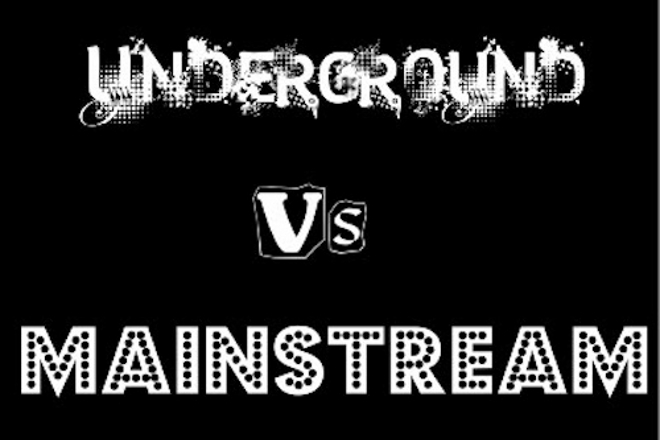Dance music has long been its worst enemy, with European vs. American, Hi-NRG vs. down-tempo, instrumental vs. production vs. DJing, and underground vs. mainstream scenes always being embroiled in smack-talking battles about how one style is better than another, one way of doing things is superior, or certain artists have more credibility than others.
Billboard’s Matt Medved suggests a truce in a recent editorial, in which he claims that the underground vs. mainstream dance music conflict has already reached its peak.
Medved makes several solid points that dance music fans of all ages ought to consider. One, the mainstream vs. underground battle really just boils down to supposed phoniness verses supposed authenticity – just like the recent incident of Seth Troxler going after Team Avicii at the International Music Summit (more on that in a moment). Particularly, he argues, you can’t blanket all artists together and paint them negatively with a single brush stroke. “It’s like equating Madonna with Milli Vanilli simply because they were both pop stars,” he said, in reference to ‘80s dance-influenced pop music.
Two, much of the trash-talking, be it from Troxler or older dance music artists going after newcomers on Twitter, comes down to how the listener first experienced it. Although older performers and the underground stick by the DJ-as-atmosphere aesthetic that pervaded raves for much of the ‘90s, the current climate shifts toward producing and how the producers present their music – really, something almost akin to a New Order or Depeche Mode show, but with a laptop and controller, instead of a synthesizer.
Part of it, as we explained a few months ago, comes from how easily accessible software is, and how the internet model of bringing music to the masses killed the DJ club residency pathway. Nevertheless, it all comes back to elevating one aspect of dance music (the old “rave” experience) over another (producing, festivals, instrumental performers, or what have you).
But the most significant argument Medved makes goes beyond the superiority/inferiority juxtaposition, which could be applied to any genre and beyond music. Medved suggests that dance music has always been fluid, and this relationship – specifically, the confluence of the underground with the mainstream with the performers with the DJs – has always been there.
Unfortunately, that’s where it ends, but one just has to look at dance music history to realize how on point he is. Take, for instance, the web between electronic dance music subgenres and pop in the ‘80s. Producers, like Stephen Hague and Shep Pettibone, shifted from working with burgeoning synthpop artists, like New Order and the Pet Shop Boys, to crafting similar sounds in a radio-friendly construct for pop stars like Madonna.
Meanwhile, producers and DJs associated with New York’s freestyle scene, like Arthur Baker, Jellybean Benitez, and John Robie, collaborated with New Order, while the rising house and techno scenes in the Midwest remixed Depeche Mode’s “Get The Balance Right,” a song some consider the unofficial first house track, when the U.K. synthesizer four-piece were having minimal success on this side of the pond. And all, if you look at the big picture, originated from disco in some form.
While trends come and go, all of the above-mentioned subgenres ended up experiencing some success, be it with freestyle and synthpop acts making it on the U.S. top 40 or house and techno finding a stronger audience in Europe later in the decade.
Of course, dance music – still associated with disco’s stigma 30 years ago – has come a long way and cemented its place in pop culture. That doesn’t mean that the fluidity is gone; rather, it takes the form of artists accepted by mainstream an underground scenes (Carl Cox and Daft Punk, for instance); mainstream artists adopting “indie” sounds, like most projects Diplo associates himself with; or successful producers going back to their roots, such as what Steve Angello claims to be doing for his next album.
However, dance music harmony – or true PLUR, if you will – not only contends with intentionally-othering guys like Troxler but multiple forces that drive fans and scenes away from each other. As EDM turns into a multibillion dollar industry, as figures from the International Music Summit suggest, the following factors indicate the mainstream versus underground conflict is far from over.
Dance Music, Inc.
At one point, “mainstream” meant soulless, faceless Eurodance, as As You Are Dance Music suggests. Still, big picture wise, a chart-topping, formulaic single is less likely to inspire hate than a company like SFX Entertainment or Live Nation buying up your promoters and events, putting it all under one umbrella of blandness.
SFX, particularly, looks to be the force truly corporatizing everything about the genre. IPOs, layoffs at Beatport, and taking everyone from Donnie Disco to Electric Zoo under its vast EDM empire erase the character of musical discovery, spontaneity, and knowing the producers and promoters aren’t in it just for the money. It’s the true representation of EDM as a faceless, one-sound monstrosity.
What’s a Hit?
As we touched on recently, the definition of a “hit” in dance music changed drastically over the past three years, but more than chart ranks, other factors are at work.
For one, the Huffington Post points out, the mainstreaming of house music – and, you might as well add dubstep along with it – comes from pop stars putting out tracks with a similar production style, be it from a collaborating house producer like David Guetta or a typically pop producer like Dr. Luke aping the style.
By contrast, an editorial in Mixmag argues, true dance music hits used to be unpredictable — not calculated for a chart rank. Rather, as history shows, it would be that U.K. Garage track making it up the singles chart or an electro artist in the early aughts finding their way onto U.S. Top 40 radio alongside pop stars and hip-hop artists.
And then the artist would never have another mainstream hit. It was as if a performer burned bright to the point of bursting with success, found it, and then returned back to his roots a stronger, changed artist. Now major labels backing dance performers expect an album or single to enter the Billboard 200’s top 20 spots – not unexpectedly squeak into the Top 100, as has been the case since the ‘80s.
Haters Gonna Hate and Put Their Thoughts on the Internet
When it comes to communication, the internet just might as well be the best and the worst invention ever. On one hand, it makes finding communities of like-minded individuals easier, rather than just depending on your local scene. On another, the “friend” who always talks about how he hates everything that’s “so mainstream” and only appreciates the records that no one else can find because only he’s listened to them now has a platform.
That’s how we get so many Deadmau5 posts about why EDM is so awful or have Troxler penning a letter about why festival culture’s the worst. Having this ability seems to make it okay to troll the International Music Summit to snidely ask Avicii’s management team if the shared production and songwriting credit is a Milli Vanilli situation.
In a sense, Troxler’s lucky because his own moderate underground cred gives him enough supposed leverage that no one dares trash his garbage, minimalist wannabe-Richie-Hawtin-but-failing-so-hard productions. Troxler’s also lucky that he’s a decent enough DJ that no one cares about his forgettable original stuff. Yet being in this underground bubble away from the attacks and hate mainstream dance music gets puts Troxler in a seemingly-comfortable position to spew this type of nonsense online and have his fans side with him against the bad, bad “Milli Vanilli” artists like Avicii.
In short, these types of guys will always exist, they’ll get attention, and their perspectives become a representation, no matter how erroneous, of a part of dance music culture.
What’s your perspective – should underground and mainstream fans finally reach a middle ground, or is this ever-growing divide just the beginning?





